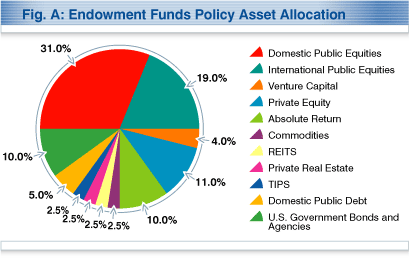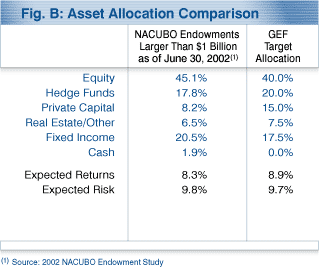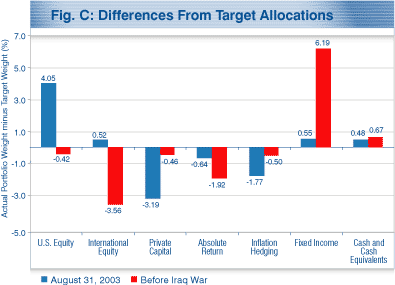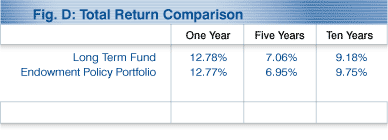|
|
 |
Investment Strategy, Asset Allocation and Performance
4. What is the investment strategy?
The GEF's strategy is to invest in a broadly diversified portfolio of equity and fixed income securities in both domestic and international markets using a long-term investment horizon. In order to earn above market returns, UTIMCO has also sharpened its focus on several asset categories categorized by complex, illiquid, and mispriced securities where proprietary information and sophisticated investment strategies offer the opportunity for value added returns. These asset categories have an additional important advantage. Because these assets typically provide returns which have a low correlation with those of the more traditional exchange-traded equities and fixed income securities in the GEF portfolio, they offer the additional advantage of reducing the overall risk level. These asset categories are generally referred to as high potential value-added assets, and include non-marketable alternative investments, marketable alternative investments, and various other specialized public market investments.
5. What is the current asset allocation of the GEF?
To properly diversify the GEF assets, UTIMCO invests in a broad variety of asset categories. This allocation policy was developed through a careful asset allocation review with the UTIMCO Board in which potential returns for each asset category were balanced against the contribution to total portfolio risk by each category. While the allocations in Figure A indicate the longer term average strategic weights of each asset category, UTIMCO repositions the allocations to each asset category from time to time in response to changes in the investment outlook.
6. How does the current asset allocation compare to other colleges and universities?
Figure B indicates how the current strategic allocation of the GEF compares with other endowment funds larger than $1 billion as reported by the National Association of College and University Business Officers (NACUBO), an endowment industry trade group. The expected returns and expected risk in Figure B are based on UTIMCO's long term capital market forecasts.
7. Has the asset allocation changed with the dramatic changes in the investment markets over the last two years?
UTIMCO has made both strategic and tactical changes to the GEF and Permanent University Fund (PUF) asset allocations as a result of the dramatic changes in the investment environment after the "internet bubble." Endowment funds enjoyed very favorable investment returns for long periods through the peak of the bubble. But, as it became apparent that those returns were no longer sustainable, the UTIMCO staff and Board recognized the need for lowered expectations regarding future returns, particularly in publicly traded stocks and bonds, and a reevaluation of how future returns sufficiently high to meet the 8.5% annual return target set for the endowment funds could be met while maintaining reasonable risk control. The result of that reevaluation is an emphasis on higher potential value-added investments in the portfolio including smaller capitalization domestic and international equities, equity investments in developing countries, specialized debt securities investments including so-called distressed debt, and hedge funds. This change in emphasis should be reflected in a revised asset allocation policy statement currently being developed for UT Board of Regents approval.
UTIMCO has responded tactically to the changing environment as well. While the markets were in freefall following the bursting of the internet bubble, UTIMCO maintained a below risk policy portfolio anchored by a large position in fixed income securities. As a result, the UT System endowment portfolios did not suffer large losses like many pension funds and some endowments did. However, as the US military entered Iraq, the endowment portfolios were changed substantially to take advantage of what we expected to be a much more favorable investment climate. An overview of those changes is shown in Figure C which indicates portfolio positions for asset categories prior to the Iraq war and at year end August 2003. The weights shown are relative to the policy portfolio weight for each asset category.
Domestic and international equities were increased to weights above the policy portfolio level from below policy levels prior to the war. The funds for the increases in equities were taken from the overweight position in fixed income prior to the war, reducing the bonds position to near policy portfolio weight. Private capital, still struggling from the burst internet bubble, was allowed to drift lower in portfolio weight. The net result of these tactical decisions was to position the endowment portfolios to take full advantage of the much more favorable environment through August, 2003. The result was significant value-added and very good overall investment results.
8. What are the significant risks associated with the GEF and how is this risk monitored?
Equity values in the GEF can fluctuate in response to the activities of individual companies, and general market conditions. In the short-term, stock prices can fluctuate dramatically in response to these factors. Bond prices in the GEF can also fluctuate based on changes in interest rates and the credit quality of the issuers. Investments in international securities in the GEF can involve political and macroeconomic risk in addition to typical individual company risks as in domestic markets. An additional element of risk in all international investments is the currency risk as the returns on those investments must be converted to US dollars for use here. Some of the longer term investments in the GEF, including venture capital and private equity, also have an element of liquidity risk due to the fact that these investments could not be easily converted to cash at short notice. All these risks are carefully monitored by both the UTIMCO staff and the UTIMCO Board. It is essential that some risks must be assumed in order to earn the levels of real returns necessary to meet the long term goals of the GEF. However, it is particularly important to carefully weigh each element of risk being assumed against the reward, in terms of future returns, expected from the assumption of that risk. The process used at UTIMCO to evaluate risks and rewards is known as risk budgeting and is almost exactly analogous to the normal budgeting process in a business. The UTIMCO staff is charged with carefully budgeting risks assumed so that the risk assumed in the aggregate does not exceed the risk limits set by the UTIMCO Board and the UT Board of Regents, and so that the expected returns are the best available at the targeted aggregate risk level. Risks are monitored daily at the UTIMCO staff level, and monthly at the UTIMCO Board level.
9. What does total return mean?
Total return measures how well an investment or group of investments, such as the LTF, have performed over a certain time period. Total return is the sum of: the change in the value (including both realized and unrealized gains and losses), plus income (from dividends or interest for example) measured over a specified period of time. Total return is usually expressed as a percentage calculated by dividing the sum defined in the prior sentence by the beginning value of an investment. Total return is also sometimes referred to as investment return or performance return. If total return is after deduction of all fees and expenses, it may also be referred to as total net return.
10. What was the total net return of the LTF over the last year? Over the last five and ten years? How does it compare to the Endowment Policy Portfolio total return?
The table in Figure D summarizes the total return comparison for the one, five and ten year periods ended August 31, 2003.
|
|
|




